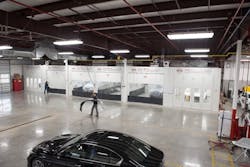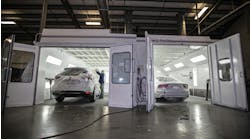In some previous columns, I shared how shop owners Jason and Dee Mignogna have worked to retain more revenue by adding services to do more types of work in-house, including truck and fleet repair, alignments and ADAS calibrations.
“My wife and I talk about: What do we still have to sublet?” Jason told me as we talked about the changes they’ve made at their business, The Collision Shoppe in Greensburg, Pa., 30 miles east of Pittsburgh.
The mix of work in this industry is changing, and the Mignognas have recognized that relying solely on traditional body work isn’t the right model moving forward. Because of ADAS, virtually every vehicle will require a wheel alignment, Jason said, and there’s new revenues associated with that alignment process. He pointed to a late model Subaru in the shop for a repair that involved no frame or structural damage, nor any damage to the tires, wheels or suspension. Because it was loaded with all the ADAS options, however, a wheel alignment was necessary.
The shop checked the OEM repair procedures for that vehicle, and found that the alignment also requires that the front distance sensor needs to be calibrated, the lane-lock camera needs to be calibrated, and the steering angle needs to be reset.
“That’s three separate not-included operations, not counting the alignment,” Jason noted. “That’s not a $79.95 alignment. In the past, we would have sent all that money out. Now we keep that all in-house.”
Being knowledgeable about a broader range of work also helps build credibility with customers as well. Jason talked about a car that recently in for collision repairs, and the customer said he’d had an alignment done at a dealership just a week before the accident. When he told Jason what he’d paid for the alignment, it seemed low. Sure enough, the dealer hadn’t performed a reset and a calibration that is a required part of the process.
“The customer couldn’t believe an independent shop knew more than a dealership shop,” Jason told me.
That knowledge does not come without a cost. Jason and his team dig for the repair information they need using ALLDATA, Mitchell’s “Tech Advisor” and CCC’s “Repair Methods.” They check I-CAR’s “Repairability Technical Support” portal. When I spoke with them, they were using a free trial of adasThink, which uses the VIN to pinpoint necessary ADAS calibrations. And Jason jokes that they have “phone-a-friend” privileges with their ADAS and alignment equipment vendors.
“It’s also the shops’ responsibility to understand that there’s value and costs associated with your knowledge, your expertise, your level of training,” Dee told me. “You can’t be bashful about getting paid for it.”
So what’s next for the Mignognas as they work to retain more of the revenues associated with today’s repairs in-house?
“The last piece of the pie is just doing our own glass work,” Jason said. “So we currently have a training session set-up. We hand-picked some of our techs, and have purchased glass equipment and tooling to be able to do it.”
That work, too, will be done within the alignment and ADAS facility, given that glass increasingly involves sensors and cameras. Jason said it will help ensure that the shop avoids a situation where it has done everything correctly on a vehicle only to have a sublet glass provider install something incorrectly.
“We also get the work done now, rather than when the glass guy has time,” Jason said.
I’m not saying every collision repair business needs to follow The Collision Shoppe’s path toward bringing every sublet service – glass, scanning alignments, ADAS calibration – in-house. But it’s clear those types of work are becoming an increasing part of the bottom line total on most estimates. Relying solely on the basics of body and paint work, without expanding into other areas (such as truck, RV or fleet work) and adding other capabilities doesn’t seem to me to be a long-term road to success in this industry.





